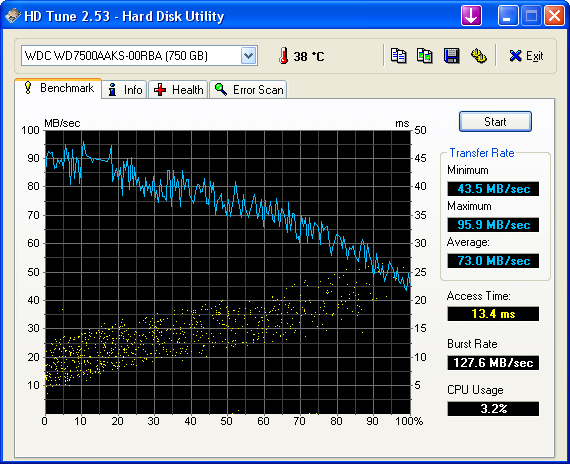Western Digital SE16 750GB: "Quiet" a Performer
by Dave Robinet on August 9, 2007 2:00 AM EST- Posted in
- Storage
HD Tune / HD Tach

In HD Tune 2.53, the Western Digital drive turns in an average sustained transfer rate of 73.0MB/s, which measures up very well against its peers. In our labs, this has been the fastest result we've recorded to date - very encouraging indeed! The 13.2ms access time reported by HD Tune is merely adequate, landing squarely within the ranks of its peers.
HD Tach clocks the sequential read speed of the 7500AAKS at an average rate of 77.1MB/s, a score again puts the WD7500AAKS above its peers. The Seagate 7200.10 750GB drive, for example, scores 66.9MB/s. The WD7500AAKS even beats the 150GB Western Digital Raptor in this test by nearly 2MB/second, which is no mean feat.
However, it is important to note that access times, average read rates, and burst rate measurements are basically synthetic measurements, and while important these are not "true" application measurements. There is a great deal of potential bottlenecks elsewhere in the system that can and will affect the true performance of a drive. Although these "benchmarks" are a good indicator of a drive's performance, it is the total make-up of components in the PC that will determine the drive's actual performance.

 |
| Click to enlarge |
In HD Tune 2.53, the Western Digital drive turns in an average sustained transfer rate of 73.0MB/s, which measures up very well against its peers. In our labs, this has been the fastest result we've recorded to date - very encouraging indeed! The 13.2ms access time reported by HD Tune is merely adequate, landing squarely within the ranks of its peers.
HD Tach clocks the sequential read speed of the 7500AAKS at an average rate of 77.1MB/s, a score again puts the WD7500AAKS above its peers. The Seagate 7200.10 750GB drive, for example, scores 66.9MB/s. The WD7500AAKS even beats the 150GB Western Digital Raptor in this test by nearly 2MB/second, which is no mean feat.
However, it is important to note that access times, average read rates, and burst rate measurements are basically synthetic measurements, and while important these are not "true" application measurements. There is a great deal of potential bottlenecks elsewhere in the system that can and will affect the true performance of a drive. Although these "benchmarks" are a good indicator of a drive's performance, it is the total make-up of components in the PC that will determine the drive's actual performance.










37 Comments
View All Comments
Dave Robinet - Thursday, August 9, 2007 - link
Actually, the difference is that the EIDE drive only is offered up to a 500GB capacity. This precludes it from having the additional features given to the 750GB drive, as mentioned in the article.If you're only using the single drive under "normal" desktop usage, however, you're not terribly likely to see a big difference in performance between a 500GB SATA and 500GB EIDE, all things being equal.
Thanks for reading!
dave
semo - Thursday, August 9, 2007 - link
i understand the sata vs. pata arguments. it's just the new features and low power draw that interest me and since the model numbers look so similar i thought that they would share the same characteristics.Frumious1 - Thursday, August 9, 2007 - link
Besides the one using a slower, outdated interface? Probably not. Thankfully, the 750GB drive is NOT available in PATA format as far as I can tell. WD's EIDE offerings top out at 500GB on their website. Seriously, who buys a top-end hard drive in EIDE format these days? Hell I only have one IDE connection on my motherboard, and that's no longer in use!semo - Thursday, August 9, 2007 - link
the 750gb version may be a top end part but the 500gb is very reasonably priced. anyway, you can never convince me that a hard drive is "high end", whatever the cost. real world performance does not vary much and depends very much on usage patterns. now an ssd or a revolutionary redesign of hdd i can consider to be high end.Dave Robinet - Thursday, August 9, 2007 - link
Agreed - if you can use SATA, you will. Some people can't, however, and the EIDE interface isn't an incredible bottleneck to the system (like, for example, the move from ISA to PCI graphics cards was in adopting the new bus).You're right, though - there's no reason to intentionally buy EIDE anymore if you have SATA available in your system. :)
Thanks for reading!
dave
Basilisk - Thursday, August 9, 2007 - link
'Won't there be negligible P-ATA demand, with none from manuf's? So, 'probably no P-ATA version, or a hefty premium on it.If my Linux distro supported the S-ATA controller chip, I'd spend the $20-$25 on a PCI or PCI-e S-ATA card and ignore the P-ATA. It would be a shame to have that P-ATA 750GB and later find yourself w/o a m/b having P_ATA to make good use of it! [Okay, you could probably buy a P-ATA controller card....]
wilburpan - Thursday, August 9, 2007 - link
Who buys a large capacity EIDE hard drive? I did recently.Why? I have an old computer that I've repurposed into a file server running Linux. This computer is old enough that it doesn't have SATA connections.